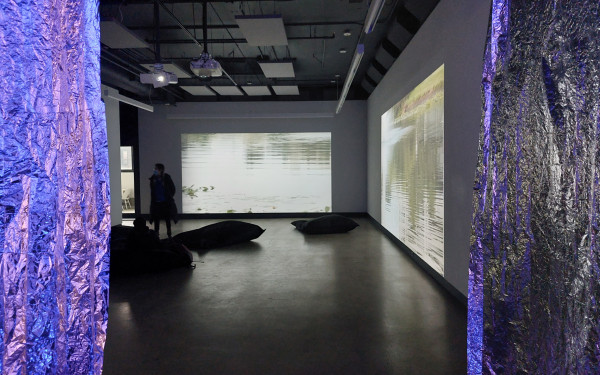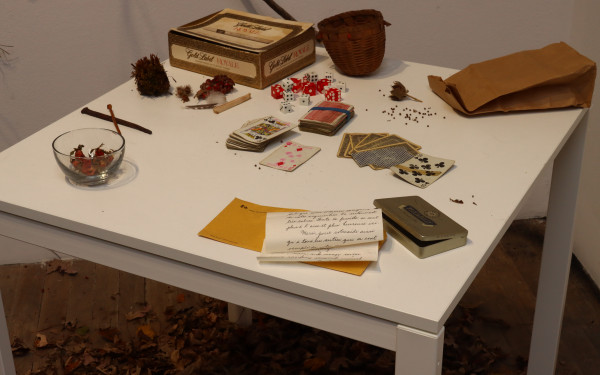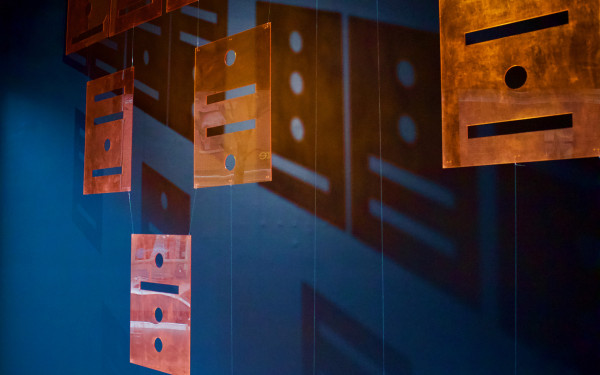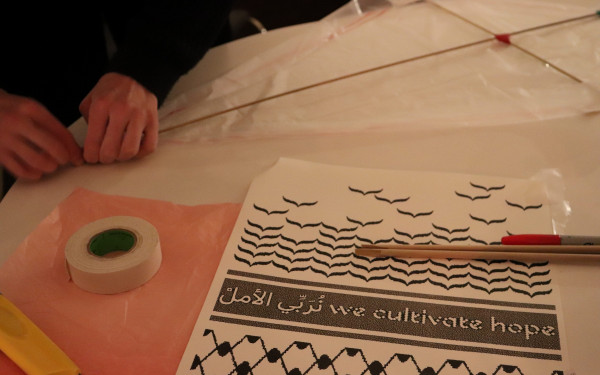Choublak: a polyphonic perspective on the Haitian diasporic experience
Ésery Mondésir’s work weaves a lively and nuanced portrait of migration, dispossession and resistance
Printed in bold red over the white walls at the entrance of the Leonard & Bina Ellen Art Gallery in Concordia’s J.W. McConnell Building, Choublak’s exhibition text welcomes visitors not in English, nor in French, but in Haitian Creole.
This choice of language is the first step into the work of multidisciplinary artist Ésery Mondésir. A rich and polyphonic journey into the Haitian diasporic experience is beyond.
According to curator Julia Eilers Smith, planning for Choublak started in the spring of 2024.
“What caught my eye about [Mondésir’s work] was his approach to documentation and documentary practices,” Eilers Smith said.
The first puzzle piece of the exhibit is Mondésir’s “What Happens to a Dream Deferred,” a 25-minute video that documents a conversation between a group of Haitians exiled in Tijuana, Mexico. In the video, they discuss their lives as they cook a pot of joumou soup. This work was a part of the gallery’s new acquisitions and a launching point for plans to program a solo show for Mondésir’s work.
Choublak visitors are invited to watch short films that combine naturalistic footage layered with poetic texts, and walk through a multi-screen “garden” of colourful hanging videos that layer contemporary Haitian songs over repurposed archival footage.
Mondésir was born in Haiti. In 2000, at the age of 28, he migrated to North America, where he worked for labour organizations in the USA and Canada.
“In a way, I am telling my own migration story,” Mondésir said, regarding his documentation work.
Even behind the camera, Mondésir is intimately present.
“All these voices help me work through the question of power between nations, between ideas, between people,” he said.
“You’ll hear him ask questions, you’ll feel the camera moving,” Eilers Smith said. “All these strategies are used to tell a story, but in a way that is different and fresh.”
The gallery also has a room, separate from the works, dedicated to photos, paintings, poetry and other artistic mediums from the collection of the International Center for Documentation and Haitian, Caribbean and Afro-Canadian Information.
“[Mondésir’s work] feels oblique,” Eilers Smith said appreciatively, commenting on the clever approach to narrative found in “What Happens to a Dream Deferred.” “It’s a bunch of guys that are cooking a soup [...] but there is a meta-narrative, and through that larger narrative we learn about their journey. That technique, that strategy, is very powerful.”
The ‘choublak,’ or hibiscus, is Haiti’s national flower. For Mondésir, it’s a polyvalent symbol of uprooting, transition and migratory practice. The hibiscus appeared at various points in Mondésir’s life: it blossomed in his childhood garden in Haiti, and as an adult, he would experiment with distillations alongside other organic substances to develop film.
In Choublak, time is non-linear. Each piece connects to another, and images and themes echo and repeat, sharing the ongoing narrative of the Haitian diasporic experience.
In the video piece “Of What Death We Die,” Mondésir’ connects memories of his father with Emmanuel Sanon’s soccer goals in the 1974 FIFA World Cup, and the racist 1980s media rhetoric around the “4H” at-risk AIDS groups—“Homosexuals, Heroin Addicts, Haitians and Hemophiliacs.”
The story continues today. While Choublak opened in mid-September, Donald Trump and other members of the U.S. Republican Party made slanderous, racist comments about Haitians eating domestic animals. These comments eerily echoed the rhetoric documented in other works, such as “Of What Death We Die.”
“It’s astonishing to witness in succession the banality of racism and dehumanization,” said visitor, artist and researcher François Lemieux. But in the face of this, Lemieux added, “[Choublak] performs something that is sorely needed: a poetic means to somehow disarm political reaction or crispation. ”
For Mondésir and Eilers Smith, Choublak’s themes even apply to the political violence and displacement in Palestine and Lebanon.
“[Choublak] is about Haiti, but it’s a case study to prove a point [and] to invite us to think about bigger issues. Hopefully, out of these connections, something bigger will emerge,” Mondésir reflected. “What does it mean to be in limbo? To have your dream interrupted but still believe it is possible to reach? What does it mean to still live?”
“What is magical about [Choublak],” Lemieux said, “[is how] tragic moments of loss, dispossessions and dehumanization are countered by moments of light, peace, collective attunement, complicity and hospitality.”
Choublak is on display at the Leonard & Bina Ellen Art Gallery until Jan. 18, 2025.

_900_600_90.jpg)
_600_832_s.png)




